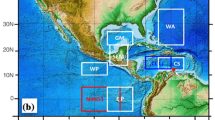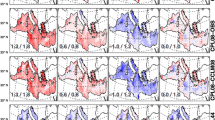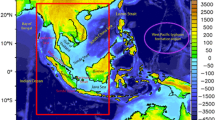Abstract
Long-term high-resolution coupled climate model simulations using the Max Planck Institute Regional Climate Model and the Max Planck Institute Ocean Model have been performed with boundary forcings from two reanalyses: firstly from the European Centre for Medium-Range Weather Forecasts, and secondly from the joint reanalysis of the National Centers for Environmental Prediction and the National Center for Atmospheric Research. This study employs a special coupling setup using a regional atmospheric model and a global ocean model. The latter model applies a special conformal grid from a bipolar orthogonal spherical coordinate system, which allows irregular positions of the poles and focuses on the detail over the Maritime Continent. The coupled model was able to simulate stable and realistic rainfall variabilities without flux correction and at two different ocean resolutions. The coupled system is integrated for a period between 1979 and 1993 and the results are then compared to those from uncoupled runs and from observation. The results show improved performance after coupling: a remarkable reduction of overestimated rainfall over the sea for the atmospheric model and of warm SST biases for the ocean model. There is no significant change in rainfall variability at higher ocean model resolution, but the ocean circulation shows less transport variability within the Makassar Strait in comparison to observations.











Similar content being viewed by others
References
Aldrian E, Susanto RD (2003) Identification of three dominant rainfall regions within Indonesia and their relationship to sea-surface temperature. Int J Climatol 23:1435–1452
Aldrian E, Gates LD, Widodo FH (2003) Variability of Indonesian rainfall and the Influence of ENSO and resolution in ECHAM4 simulations and in the reanalyses. MPI Report 346 (Available from Max Planck-Institut für Meteorologie, Bundesstr. 55, D-20146, Hamburg)
Aldrian E, Jacob D, Podzun R, Gates LD, Gunawan D (2004) Long term simulation of the Indonesian rainfall with the MPI Regional Model. Clim Dyn 22:795–814
Arakawa A, Lamb VR (1977) Computational design of the basic dynamical processes of the UCLA general circulation model. Methods Comput Phys 17:173–265
Berliand ME, Berliand TG (1952) Determining the net long-wave radiation of the earth with consideration of the efects of cloudiness. Isv Akad Nauk SSSR Ser Geo s 1:64–78
Budyko MI (1974) Climate and life in Int Geophys Ser, Academic, San Diago
Cressman GP (1959) An operational objective analysis scheme. Mon Weather Rev 117:765–783
Gibson JK, Kallberg P, Uppala S, Hernandez A, Nomura A, Serrano E (1997) The ECMWF Re-Analysis (ERA) 1. ERA Description. ECMWF Reanalysis Project Report Series 1 ECMWF, p 71 (Available from the European Centre for Medium-range Weather Forecasts, Reading)
Gordon AL, Susanto RD, Ffield A (1999) Throughflow within Makassar Strait. Geophys Res Lett 26:3325–3328
Hackert EC, Hastenrath S (1986) Mechanism of Java rainfall anomalies. Mon Weather Rev 114:745–757
Hendon HH (2003) Indonesian rainfall variability: Impacts of ENSO and local air-sea interaction. J Clim 16:1775–1790
Huffman GJ, Adler RF, Arkin P, Chang A, Ferraro R, Gruber A, Janowiak J, McNab A, Rudolf B, Schneider U (1997) The Global Precipitation Climatology Project (GPCP) combined precipitation data set. Bull Amer Meteor Soc 78:5–20
Jacob D (2001) A note to the simulation of the annual and inter-annual variability of the water budget over the Baltic Sea drainage basin. Met Atmos Phys 77:61–73
Jacob D, van den Hurk BJJM, Andræ U, Elgered G, Fortelius C, Graham LP, Jackson SD, Karstens U, Köpken C, Lindau R, Podzun R, Roeckel B, Rubel F, Sass BH, Smith RNB, Yang X (2001) A comprehensive model inter-comparison study investigation the water budget during the BALTEX-PIDCAP period. Met Atmos Phys 77:19–43
Jakob C (2000) The representation of cloud cover in atmospheric general circulation models. PhD Thesis Ludwig-Maximilians-Universitat, Munchen (Available from the European Centre for Medium-range Weather Forecasts, Reading) 190 pp
Kalnay E, Kanamitsu M, Kistler R, Collins W, Deaven D, Gandin L, Iredell M, Saha S, White G, Woollen J, Zhu Y, Chelliah M, Ebisuza W, Higgins W, Janowiak J, Mo KC, Ropelewski C, Wang J, Leetmaa A, Reynolds R, Jenne R, Joseph D (1996) The NCEP/NCAR 40-year reanalysis project. Bull Amer Meteor Soc 77:437– 471
Legutke S, Voss R (1999) The Hamburg atmosphere-ocean coupled circulation model ECHO-G. Technical Report 18 German Climate Computing Center Hamburg, p 61
Levitus S, Boyer TP, Conkright ME, O’Brien T, Antonov J, Stephens C, Stathoplos L, Johnson D, Gelfeld R (1998) World Ocean database 1998. In: Introduction. NOAA Atlas NESDIS 18, Ocean Climate Laboratory, National Oceanographic Data Center, Vol 1, US Government Printing Office, Washington
Majewski D (1991) The Europa Modell of the Deutscher Wetterdienst. In: ECMWF Seminar Proceedings ECMWF Reading, pp 147–191
Marsland SJ, Wolff JO (1998) East Antartic seasonal sea-ice and ocean stability: a model study. Ann Glaciol 27:477–482
Marsland SJ, Wolff JO (2001) On sensitivity of Southern Ocean sea ice to the surface fresh water flux: a model study. J Geophys Res 106:2723–2741
Marsland SJ, Haak H, Jungclaus JH, Latif M, Röske F (2003) The Max-Planck Institute global ocean/sea ice model with orthogonal curvilinear coordinates. Ocean Model 5:91–127
Meier HEM, Döscher R, Faxén T (2003) A multiprocessor coupled ice-ocean model for the Baltic Sea: application to salt inflow. J Geophys Res 108:C8–3273
Nicholls N (1979) A simple air-sea interaction model. Quart J Roy Meteor Soc 105:93–105
Peterson TC, Vose R, Schmoyer R, Razuvaev V (1998) Global Historical Climatology Network (GHCN) quality control of monthly temperature data. Int J Climatol 18:1169–1179
Press WH, Flannery BP, Teukolsky SA, Vetterling WT (1996) Numerical recipes in C Vol. 2 Cambridge University Press, Cambridge, p 963
Rayner NA, Horton EB, Parker DE, Folland CK, Hackett RB (1996) Version 2.2 of the global sea-ice and sea-surface temperature data set, 1903-1994. Technical Note CRTN74. Clim Res p 35
Roeckner E, Arpe K, Bengston L, Christoph M, Claussen M, Dumenil L, Esch M, Giorgetta M, Schlese U, Schulzweida U (1996) The atmospheric general circulation model ECHAM-4: Model description and simulation of present-day climate. MPI Report 218, p 90 (Available from Max Planck-Institut für Meteorologie, Bundesstr. 55, D-20146, Hamburg)
Röske F (2001) An Atlas of surface fluxes based on the ECMWF Re-Analysis: a climatological dataset to force global ocean general circulation models. MPI Report 323 (Available from Max Planck-Institut für Meteorologie, Bundesstr. 55, D-20146, Hamburg)
Schrum C, Hubner U, Jacob D, Podzun R (2003) A coupled atmosphere/ice/ocean model for the North Sea and the Baltic Sea. Clim Dyn 21:131–151
Simmons AJ, Gibson JK (2000) The ERA-40 Project Plan. ERA-40 Project Report Series 1 ECMWF, p 62 (Available from the European Centre for Medium-range Weather Forecasts, Reading)
Terray L, Valcke S, Piacentini A (1999) OASIS 2.3 Ocean atmosphere sea ice soil user’s guide. Technical Report TR/CGMC/99-37 CERFACS p 82
Valcke S, Terray L, Piacentini A (2000) The OASIS Coupler User’s Guide, Version 2.4. Technical Report TR/CGMC/00-10 CERFACS, p 85
Vose RS, Schmoyer RL, Steurer PM, Peterson TC, Heim R, Karl TR, Eischeid JK (1992) The Global Historical Climatology Network: Long-term monthly temperature, precipitation, sea level pressure, and station pressure data. ORNL/CDIAC-53 NDP-041 p 325
Wolff JO, Maier-Reimer E, Legutke S (1997) The Hamburg Ocean Primitive Equation Model HOPE. Technical Report 13 German Climate Computer Center (DKRZ) Hamburg, p 98
Acknowledgements
The first author is very grateful for the DAAD scholarship A/99/09410. We thank Prof. Hartmut Graßl who reviewed an early version of the manuscript and supervised the study. Special thanks to R. D. Susanto and Tien Sribimawati for providing Indonesian throughflow and some rainfall data, respectively. Calculations have been performed at the Deutsches Klimarechenzentrum (DKRZ).
Author information
Authors and Affiliations
Corresponding author
Additional information
This paper has not been published or considered by any other journal in any language.
Rights and permissions
About this article
Cite this article
Aldrian, E., Sein, D., Jacob, D. et al. Modelling Indonesian rainfall with a coupled regional model. Climate Dynamics 25, 1–17 (2005). https://doi.org/10.1007/s00382-004-0483-0
Received:
Accepted:
Published:
Issue Date:
DOI: https://doi.org/10.1007/s00382-004-0483-0




